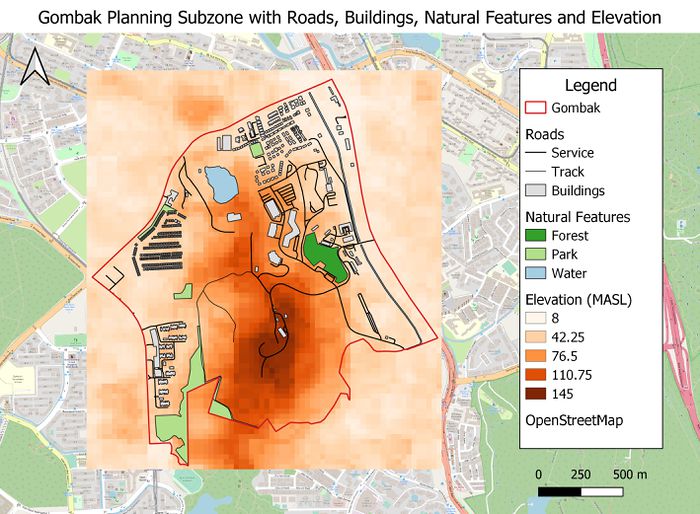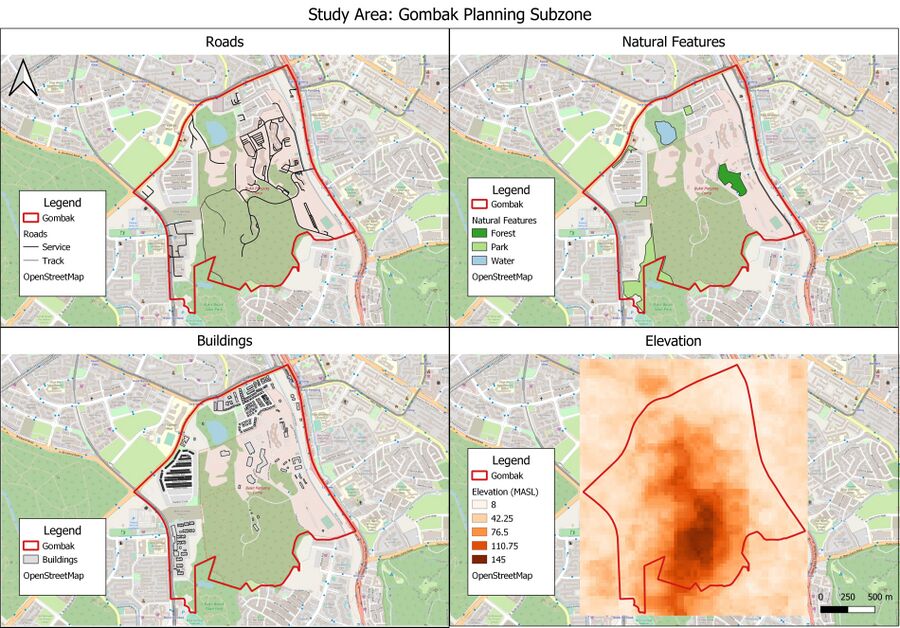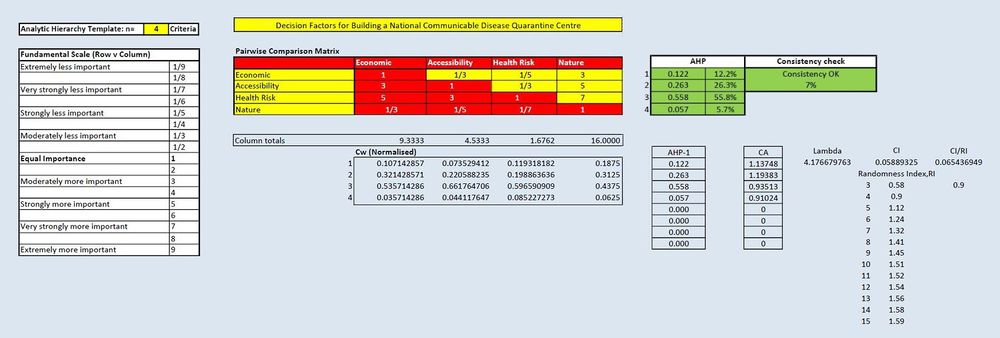Difference between revisions of "SMT201 AY2019-20T1 EX2 Chong Yun Yu"
| Line 34: | Line 34: | ||
=== Proximity to Roads === | === Proximity to Roads === | ||
| − | Darker values depict a higher suitability of land lot in the accessibility factor. The distance from a 5 meters by 5 meters land lot to the nearest road is 0 meters, and the furthest distance is 717 meters. In the map above, all land lots with distance to the nearest road of at least | + | Darker values depict a higher suitability of land lot in the accessibility factor. The distance from a 5 meters by 5 meters land lot to the nearest road is 0 meters, and the furthest distance is 717 meters. In the map above, all land lots with distance to the nearest road of at least 200 meters are shown in white. |
=== Proximity to Buildings === | === Proximity to Buildings === | ||
Revision as of 20:33, 6 November 2019
Contents
Building a National Communicable Disease Quarantine Centre
To identify a location suitable for building a National Communicable Disease Quarantine Centre, there is a need to first look at the points of interests in Gombak planning subzone. Four decision factors that are particularly relevant have been identified:
- Accessibility factor: proximity to local roads, such as service roads and tracks
- Health risk factor: proximity to population, in particular proximity to buildings
- Natural conservation factor: proximity to natural features, such as parks, forests, and water bodies
- Economic factor: steepness of slope
These factors will be discussed in more detail below.
Data Source: Master Plan 2014 Subzone Boundary (No Sea) (SHP) from URA.[1]. Roads, Buildings and Natural (SHP) from OpenStreetMap.[2]. ASTER Global Digital Elevation Model (GDEM) dataset (TIFF) jointly prepared by NASA and METI, Japan; raster dataset combined by Professor Kam Tin Seong.[3].
Data Source: Master Plan 2014 Subzone Boundary (No Sea) (SHP) from URA.[4]. Roads, Buildings and Natural (SHP) from OpenStreetMap.[5]. ASTER Global Digital Elevation Model (GDEM) dataset (TIFF) jointly prepared by NASA and METI, Japan; raster dataset combined by Professor Kam Tin Seong.[6].
Accessibility Factor (Roads)
The selected site should be close to local roads to ensure easy transportation of building materials during the construction stage. The roads are shown in a line vector, and are categorized into service roads, which are shown using thicker strokes; and tracks, which are shown using thinner strokes. There are 199 service roads and only 2 tracks. The service roads spread across most of the Gombak planning subzone, and are mostly concentrated in the North-East region, whereas the 2 tracks are located at the South and central region of Gombak.
Health Risk Factor (Buildings)
The selected site should be away from population to prevent the diseases from spreading to the public. Seven types of buildings have been identified from the data provided from OpenStreetMap, they include clinic, construction site, garage, place of worship, public space, residential area, and train station. However, out of the 527 buildings identified in Gombak, 505 buildings are of "unknown" type in the data provided. Hence, it would not be meaningful to categorize the buildings based on their type. All buildings are treated as population indicators, and the selected site should be away from the buildings.
Natural Conservation Factor (Natural Features)
The selected site should be also be away from natural features, such as forests, parks and water bodies. There are 1 forest, 4 parks and 3 water bodies identified. All of these natural features are located near the peripherals of the Gombak planning subzone. The forest is depicted with dark green on the map, while the parks and the water bodies are depicted using light green and light blue respectively.
Economic Factor (Elevation)
Lastly, the selected site should avoid steep slopes to reduce the development costs for cut-and-fill construction techniques. The lowest point in Gombak is 8 meters above sea level, depicted in light orange. The Southern region of Gombak has the highest elevation with 145 meters above sea level, depicted in dark orange. Only around 1% of the buildings and 4% of the local roads in Gombak are located in the region with the highest elevation. All natural features are located within the low-lying areas of Gombak.
Proximity Analysis on the Four Decision Factors
To select a suitable site, a proximity analysis is needed to show the closeness of all land lots in Gombak to the identified features of interest. In general, darker values in the maps below depict higher closeness to the features of interest, and lighter values depict lower closeness.
Data Source: Master Plan 2014 Subzone Boundary (No Sea) (SHP) from URA.[7]. Roads, Buildings and Natural (SHP) from OpenStreetMap.[8]. ASTER Global Digital Elevation Model (GDEM) dataset (TIFF) jointly prepared by NASA and METI, Japan; raster dataset combined by Professor Kam Tin Seong.[9].
Proximity to Roads
Darker values depict a higher suitability of land lot in the accessibility factor. The distance from a 5 meters by 5 meters land lot to the nearest road is 0 meters, and the furthest distance is 717 meters. In the map above, all land lots with distance to the nearest road of at least 200 meters are shown in white.
Proximity to Buildings
Land lots with lighter values have higher suitability to be chosen to build the quarantine center because these locations are further away from the population. The distance from a 5 meters by 5 meters land lot to the nearest building is 0 meters, and the furthest distance is 816 meters. All land lots with distance to the nearest building of at least 262 meters are shown in white in the map above.
Proximity to Nature
Land lots that are further away from natural features have lighter values in the map, and they have higher suitability to be chosen to build the quarantine center. The distance from a 5 meters by 5 meters land lot to the nearest forest, park or water body is 0 meters, and the furthest distance is 848 meters. All land lots with distance to the nearest natural feature of at least 355 meters are shown in white in the map above.
Slope Analysis
Slopes are calculated using proximity to elevation. Land lots with darker values have flatter surfaces, and thus they have higher suitability to build the quarantine center. The minimum steepness of a 30 meters by 30 meters land lot is 0 degrees, which indicates flat land; while the maximum steepness is 37 degrees. As seen from the map, most of the land lots in Gombak are flat, despite the rather uneven elevation in the region.
Criterion Scores on the Four Decision Factors
As it is difficult to determine the exact land lots that are suitable for building a quarantine centre by looking at the proximity analysis results, further analysis needs to be done. A higher score indicates that the land lot is more suitable in that category and thus it is more preferred.
Data Source: Master Plan 2014 Subzone Boundary (No Sea) (SHP) from URA.[10]. Roads, Buildings and Natural (SHP) from OpenStreetMap.[11]. ASTER Global Digital Elevation Model (GDEM) dataset (TIFF) jointly prepared by NASA and METI, Japan; raster dataset combined by Professor Kam Tin Seong.[12].
Accessibility Score
Health Risk Score
Natural Conservation Score
Economic Score
Analytical Hierarchical Process Input Matrix and Result Report
Data Source: AHP Template from SCBUK (XLS).[13]
The report is generated using the AHP template from SCBUK.
Suitable Land Lots Identified
(insert file)
Data Source:
text



